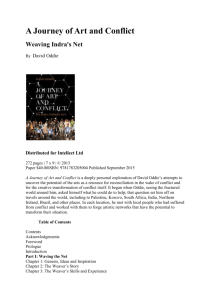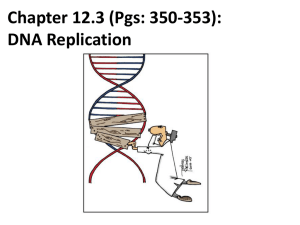presentation
advertisement
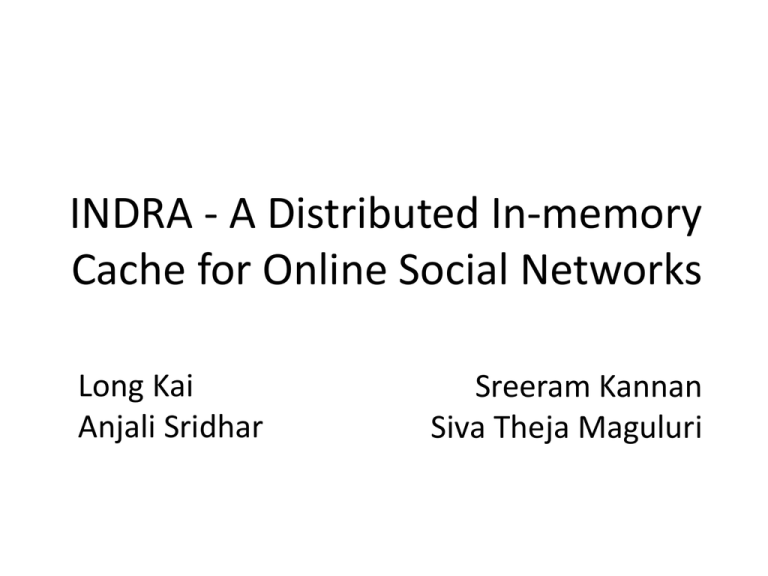
INDRA - A Distributed In-memory Cache for Online Social Networks Long Kai Anjali Sridhar Sreeram Kannan Siva Theja Maguluri Motivation – “big multi-get” • Memcached – In-memory distributed hash table service used in Facebook • 400k connections to any Memcached server – Estimated 5 GB memory is required to maintain TCP connections – Replace TCP with UDP • High Communication overhead Related Work - SPAR • In the consistent storage(SPAR): – Scalability: on average 7 copies are stored – System flexibility: confined to multi-get applications of small data items – Algorithmic flexibility: inefficient dynamic adaptation of new usage pattern – Reliability: complicated failure recovery mechanism – Load-balancing J.M. Pujol, V. Erramilli, G. Siganos, X. Yang, N. Laoutaris, P. Chhabra, and P. Rodriguez. The little engine (s) that could: Scaling online social networks. InACM SIGCOMM Computer Communication Review ,volume 40, pages 375–386. ACM, 2010. Indra CLIENT INDRA SERVER (MEMORY-CACHE) CONSISTENT STORAGE Guarantees: 1. Most recent copy is present in the primary. 2. Secondary copies are eventually consistent. Design principles: 1. Reliance on the consistent storage for failure recovery. 2. Idempotent operations only Advantages • Modularity: Data reliability is decoupled from the partition and replication algorithm module. • Flexibility: Use of caching and eviction at individual servers to dynamically adapt to new usage patterns. Algorithm • Indra objectives – To place friends’ data together – To replicate popular data items – Based on access log • Weighted graph; weights denote joint access frequency e a d c c Placement b d Replication f Mathematical Model Collocate user with friends Maximize Balance the load among servers Minimize replicas Collocation Server Load Replication Cost Gain Cost Among all • Placement plans • Replication plans Problem incorporates several NP-Hard problems! Problem Decomposition Key Idea: Separate the problem into two simpler problems! Partitioning Problem Replication Problem Maximize Collocation Server Load Gain Cost Among all Placement plans Maximize Collocation Replication Gain Cost Replication plans Among all Online Algorithm • Current state of system • User 𝑔 arrives • Compare the two possible placements h e a d c c d – Assigned to server 1 • Replicated at server 2 • User ℎ arrives – Placement trades off collocation gain and load balancing cost b g g g f Evaluation • Data Set – Random Walk on Facebook Data Set from Max Planck Institute for Software Systems – 6373 vertices and 183,734 edges; average 28.83 neighbors • Metrics – Number of Connections – Number of TCP packets • Experimental Setup – – – – – 10 / 15 Servers, Consistent Storage interface, Offline algorithm 1000 read requests Tcpdump and Wireshark for bandwidth analysis Bandwidth : Indra Vs Random 50000 46757 45000 38893 40000 35000 30000 Number of 25000 TCP Packets 20000 Indra Random 15538 15000 12799 Replication Factor: 10 Servers: 1.2 15 Servers :1.8 10000 5000 0 10 15 Number of Servers Trade off between Replication and Connections Contributions • Proposed In-Memory Distributed Cache – Takes advantage of data access relationships – Retrieves small data items in Online Social Networks – Uses Dynamic Partition and Replication Algorithm • Results show – Factor of 4 decrease in the number of TCP packets – Can trade off Replication for number of connections Thanks!


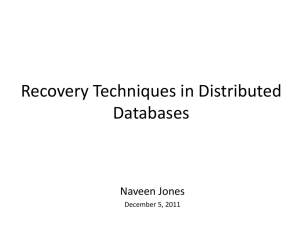
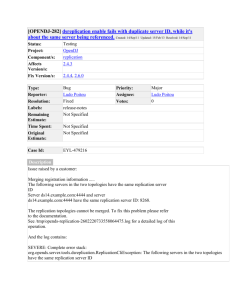


![[#OPENDS-2424] impact of generation ID on binary copy](http://s3.studylib.net/store/data/007269618_1-6a8ffff756074c5dc52b3b35a3c7785c-300x300.png)
